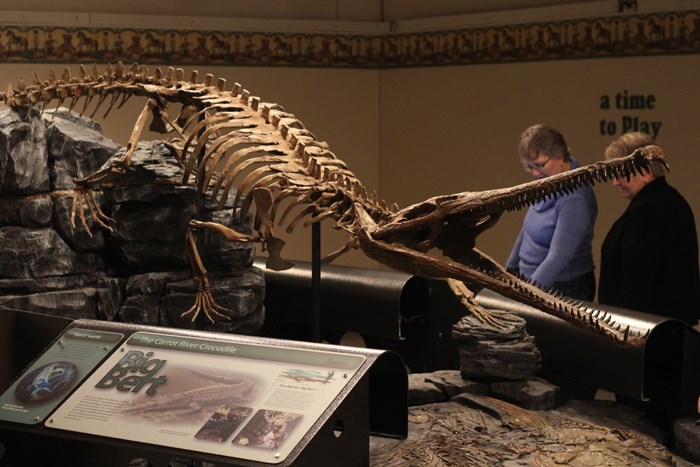The Western Development Museum has always been focused on bringing Saskatchewan’s history to life. With the arrival of Big Bert, the museum is showing Saskatchewan’s ancient past. The 92 million year old crocodile is one of the species which used to live in the province.
Big Bert is a Terminonaris robusta crocodile, which was found in shallow water in the period in which he lived. Dr. Ryan McKellar, Paleontologist with the Royal Saskatchewan Museum, says it is a showcase specimen for the species. Tim Tokaryk, Curator of Vertebrate Paleontology at the Royal Saskatchewan Museum worked on the find, which was discovered in the banks of the Carrot River in 1991.
“It ranks in the top ten at least for finds in Saskatchewan paleontology,” McKellar says.
One of the reasons why it’s one of the top finds in the province is how complete it is. The 5.6 m long skeleton, which includes a skull that’s over one meter long, represents the most complete example of the species.
“It’s rare to find a complete skeleton or mostly complete skeleton like this. It’s a good day in vertebrate paleontology if we find half a skeleton.”
The display itself also uses 3D imaging to give a more complete look at what Big Bert might have looked like in his prime.
The fossil also is an example of how the province has changed dramatically over millions of years. While a prairie province now, in the time when animals like Big Bert lived the province was a very different place. McKellar explains that in the cretaceous period there was a lot going on, such as the western interior seaway, a narrow seaway that stretched from Alaska to the Gulf of Mexico. That left behind marine shales that contained marine reptiles, as well as coastal animals like these crocodiles and dinosaurs.
“Saskatchewan has a very rich fossil history, and this is just one of the windows into how conditions have changed pretty dramatically over the last 92 million years. I think this is a pretty good example of how much things have changed.”
The skeleton is a replica of the original fossil, something McKellar describes as necessary due to the fragility and weight of the original fossil. By making a replica, they can make an example for display which can be used to showcase the find to people in the province.
“The skull, the top half of it, the original was about 100 lbs, so hanging it on a wire bracket was almost impossible, and if you wanted to move it around and share it with different communities there was no way without it getting damaged in the travel process. This is our way to share specimens fairly quickly and without accumulating damage.”
Big Bert travels the province because they want to get kids interested in sciences and natural history, McKellar explains. The goal is to use an exciting find like this one to get kids interested in the world around them.
“It’s a nice gateway to get people interested into natural history and the sciences.”
This is the third fossil to make its way to Yorkton, as part of a partnership with the Royal Saskatchewan Museum and the Western Development Museum, with Yorkton previously hosting Scotty the T-Rex and Omaciw, a Tylosaurus.



